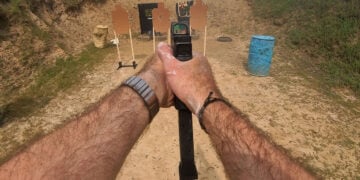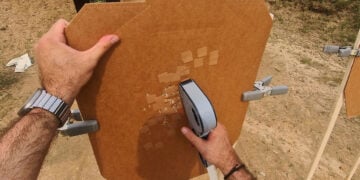“Slow is fast and fast is slow”
If you’ve ever heard this saying and scratched your head in confusion, don’t worry — you’re not alone. It’s a confusing saying but it’s popped up in military circles to describe training tempo. When you need high speed, low-drag performance, you don’t start off going at 100 mph. You start with getting each individual piece of a movement correct.
Think about it like learning to play piano. If you’ve never seriously picked up playing the piano in your life and sit down and stare at a piece from Mozart, you’re going to be understandably lost. Even if you’re an experienced piano player, it will take you time to learn the piece. That comes with practice, repetition, and focusing on hitting the marks correctly.
It doesn’t matter if you can do complex concealed carry handgun maneuvers if you can’t reliably hit your target or transition between magazines. It’s even more dangerous if you think you’re good — but you’re actually a soup sandwich.
Here’s five ways to be constantly improving your firearm accuracy…
Gradual Improvement Instead Of Zero To Sixty Performance
Think about all those YouTube videos you’ve seen where the Navy Seal operator busts through the door and seamlessly cycles magazines, hitting targets left and right. He wasn’t born doing that. And the majority of concealed carriers will never need or want to have those skills. When you’re at the range, break down the major pieces of any concealed carry encounter. They are:
- Situational Awareness — Active scan around your location.
- Target Acquisition — Target is identified and shooter knows what is in front and behind his target.
- Holster Draw And Immediate Fire — This is a complex movement. We’ll get into it.
- Movement To Cover — If you’re standing out in the open trading bullets with the enemy, you’re a fool.
- Magazine Change And Immediate Fire — Another complex movement.
- Situational Awareness — Active scan for threats.
- Reholstering — This is the last thing you do when you’re positive the fight is over.
Drill 1: Front Sight Post Focus Drills
This is a set of rounds dedicated to marksmanship. Speed isn’t necessary right up front. You want to really focus your attention on the front sight post and it’s alignment with the target. If your rounds are going all over the place, you need to put more focus on paying close attention to where that front sight post goes.
Drill 2: Magazine Change Drills
Load two magazines of three rounds each. Focus on placing those rounds as accurately as possible but get used to switching magazines like you would in real life. That means if you carry a magazine in your extra mag pouch or back pocket — that’s where you put it. If you’re not comfortable with the speed or fluidity of this transition, consider switching it up until you find a pattern that works great for you.
Drill 3: Transition To Cover
With a target placed at 15 yards or more, this is an excellent opportunity to practice taking cover. Use benches, tables, or whatever is convenient and allowable at your range to demonstrate to yourself you’re able to push to cover before engaging target.
Drill 4: Long Range Pistol Shooting
If your target is 40 to 50 yards away, you likely won’t be engaging him with a pistol. However, 20 to 30 yards is still a decent range to get familiar with. For these exercises, always practice drawing from your holster. Even if you need to take more time to acquire target — do it. Speed will come with successful practice.
Drill 5: Close Range Instinctive Shooting
This prepares you for the harsh realities of real world encounters where you don’t have the element of surprise or initiative. With a target at 5 yards or less, draw and fire. Always incorporate drawing from your concealed carry holster in the exact manner you intend to do so in the real world. This is the only way to develop the instinctive muscle memory to do it in real life. Emphasis on keeping your finger off of the trigger until you are ready to fire and always staying alert.









